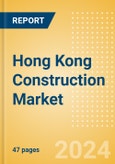Following an estimated growth of 10.8% in 2023, the publisher expects the Hong Kong construction industry to contract in 2024, declining by 1.2% in real terms this year, owing to tight financial conditions, high inflation and elevated interest rates. The outlook for Hong Kong’s construction industry is also associated with key risks, including the slowing of economic growth in China, increased material, labor and energy costs and the impact of a continued rise in interest rates on new construction investment. Moreover, according to the latest figures from the Land Registry office, the total number of sales and purchase agreements of residential and non-residential buildings processed fell by 3.2% YoY in the first eleven months of 2023, reflecting weak demand for new buildings, which will further subdue investor confidence in short term.
The publisher expects the construction industry in Hong Kong to register an annual average growth of 2.3% from 2025-28, supported by investment in the transport, electricity, housing, and industrial sectors. The industry’s output will be supported by the government’s commitment to the development of three major road schemes and three strategic railway projects to drive and support the city's development by 2030. It involves six projects that will result in a highly interconnected and accessible road network and rail system, as per the Strategic Studies on Railways and Major Roads beyond 2030. Furthermore, the government has set aside HKD10 billion ($1.3 billion) for the completion of construction works to upgrade and expand university healthcare teaching facilities in order to accommodate approximately 900 additional healthcare training places by 2026. Growth over the forecast period will also be supported by the government’s Long-Term Housing Strategy that involves the construction of 330,000 public housing units by 2032 on 350ha of land with an investment of HKD5 billion ($638.4 million) to address connectivity issue and housing deficits.
The Construction in Hong Kong - Key Trends and Opportunities to 2028 (H1 2024) report provides detailed market analysis, information, and insights into Hong Kong's construction industry, including -
The publisher expects the construction industry in Hong Kong to register an annual average growth of 2.3% from 2025-28, supported by investment in the transport, electricity, housing, and industrial sectors. The industry’s output will be supported by the government’s commitment to the development of three major road schemes and three strategic railway projects to drive and support the city's development by 2030. It involves six projects that will result in a highly interconnected and accessible road network and rail system, as per the Strategic Studies on Railways and Major Roads beyond 2030. Furthermore, the government has set aside HKD10 billion ($1.3 billion) for the completion of construction works to upgrade and expand university healthcare teaching facilities in order to accommodate approximately 900 additional healthcare training places by 2026. Growth over the forecast period will also be supported by the government’s Long-Term Housing Strategy that involves the construction of 330,000 public housing units by 2032 on 350ha of land with an investment of HKD5 billion ($638.4 million) to address connectivity issue and housing deficits.
The Construction in Hong Kong - Key Trends and Opportunities to 2028 (H1 2024) report provides detailed market analysis, information, and insights into Hong Kong's construction industry, including -
- Hong Kong's construction industry's growth prospects by market, project type, and construction activity
- Critical insight into the impact of industry trends and issues, as well as an analysis of key risks and opportunities in Hong Kong's construction industry
- Analysis of the mega-project pipeline, focusing on development stages and participants, in addition to listings of major projects in the pipeline.
Scope
This report provides a comprehensive analysis of the construction industry in Hong Kong. It provides -- Historical (2019-2023) and forecast (2024-2028) valuations of the construction industry in Hong Kong, featuring details of key growth drivers.
- Segmentation by sector (commercial, industrial, infrastructure, energy and utilities, institutional and residential) and by sub-sector
- Analysis of the mega-project pipeline, including breakdowns by development stage across all sectors, and projected spending on projects in the existing pipeline.
- Listings of major projects, in addition to details of leading contractors and consultants
Reasons to Buy
- Identify and evaluate market opportunities using standardized valuation and forecasting methodologies.
- Assess market growth potential at a micro-level with over 600 time-series data forecasts.
- Understand the latest industry and market trends.
- Formulate and validate strategy using critical and actionable insight.
- Assess business risks, including cost, regulatory and competitive pressures.
- Evaluate competitive risk and success factors.
Table of Contents
1 Executive Summary2 Construction Industry: At-a-Glance6 Construction Market Data
3 Context
4 Construction Outlook
5 Key Industry Participants
7 Appendix
List of Tables
List of Figures








